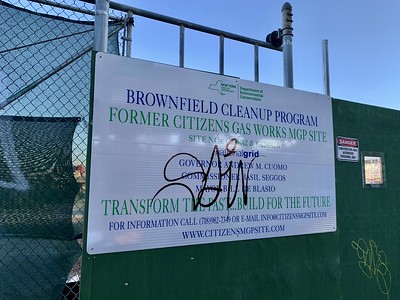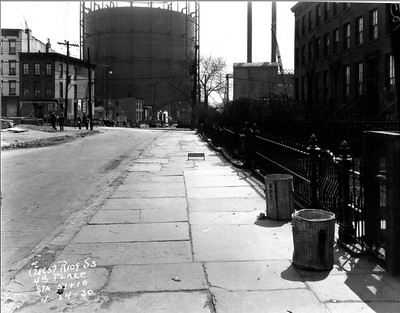
Public Place on Smith Street near 5th Street
A 1930 view of the former Citizens Gas Work Site on what is now Public Place
An arial view of the Citizens Gas Work site in 1926
Councilmember Brad Lander, supporter of housing on Public Place
Gowanus Green: a proposal for 1000 apartments and a school on permanently toxic land
By now, most residents in Gowanus and neighboring areas have hopefully heard about the proposal by the NYC Department of City Planning to up-zone the Gowanus Canal area, which calls for 8,200 new units of housing that will bring approximately 20,000 new residents to the area.
The rezoning will likely go forward early next year as it moves through the Uniform Land Use Process (ULURP) despite the fact that it will still take years for the Canal to be environmentally remediated as part of the EPA Superfund Clean-up, and despite the fact that the City still uses the waterway as an open sewer and that the area's infrastructure is already stretched to its limits under current conditions. The area is also a FEMA Flood Zone A.
The ULURP process, once it starts, should take between six to nine months. If the rezoning goes through, developers who have already purchased the land around the Gowanus can start building 22 to 30 story high rises.
If this seems insane to most, the plan has nevertheless the backing of Councilman Brad Lander, who has supported the rezoning from the start.
Though it appears on the surface that Lander wants to make sure that "plans for growth are grounded fully in the public interest, and will achieve our shared goals", the rezoning of the Gowanus area was always a huge giveaway to developers despite all the talk about affordable housing units that may be gained in the process.
Which brings us to Public Place, the City-owned six acre Brownfield site near the intersection of Smith and 5th Streets adjacent to the Gowanus Canal. It is currently in NYC Department of Housing Preservation and Development portfolio.
Brad Lander has been pushing for the development of housing on Public Place from the moment he ran for City Council, if not before. From 1993 to 2003, he served as executive director of Park Slope's Fifth Avenue Committee, a not-for-profit community-based organization that develops and manages affordable housing.)
Interestingly enough, in 2008, Fifth Avenue Committee, together with Hudson Companies, Jonathan Rose, and the Bluestone Organization was selected to develop the site for affordable housing with retail space, community facilities and open space.
Fifth Avenue Committee's current executive director is Michelle de la Uz, who also currently serves as a Commissioner of NYC Planning Commission. If that is not a conflict of interest, what is?
Their proposal was named 'Gowanus Green' and included 774 units of housing, of which 70% would have been permanently affordable. To move forward, the site needed to go through a rezoning from manufacturing to residential, which never moved forward after the Environmental Protection Agency declared the Gowanus Canal a Superfund Site.
Gowanus Green has been revived of late since City Planning has wrapped Public Place into the framework of the agency's Gowanus Neighborhood Planning Study.
The new plan for Public Place calls for 1000 units of 100% affordable housing in 30 story buildings as well as a new public school.
This Monday, December 2, the NYC Department of City Planning and NYC Housing, Preservation, and Development will be presenting an update on the Public Place / Gowanus Green site to Community Board 6 at PS 32.
Ahead of the meeting, Brad Lander's office released a statement that reads in part:
"The chance to build a sustainable, mixed-income community in Gowanus is one of the most important and unique opportunities of the Gowanus Neighborhood Rezoning. Gowanus sits in-between Carroll Gardens and Park Slope, two wonderful neighborhoods, with great schools, thriving commercial strips, great access to transit -- and almost no affordable housing. Gowanus Green offers us the opportunity to build hundreds of units of truly affordable housing, right at the heart of the neighborhood, to open up the opportunity of our dynamic community to a much wider range of people than can afford to live here now."
Affordable housing, additional parkland, a new public school...it all sounds great, until you consider the history of Public Place, which Brad Lander refuses to mention in his email to the community.
The truth is that to this day, Public Place remains one of, if not the most polluted site along the Gowanus Canal and needs extensive remediation.
From the 1860s to the early 1960s, the Public Place site was the home of the former Citizens Gas Light Company's 12th Ward Gas Work Plant, a Manufactured Gas Plant (MGP) where coal and petroleum products were turned into flammable gas. The gas was used for cooking, lighting, heating and commercial purposes in the surrounding neighborhoods.
Unfortunately, one of the by-products of this gasification process is coal tar, a black viscous liquid, which is harmful to humans and the environment. At Public Place, coal tar has been found in significant amounts at depths of 150 feet.
When the Citizens Gas Works plant was decommissioned in the 60s, the site was given to the city 'by condemnation' as public land in 1975. Hence the name "Public Place". Citizens Gas Light Company later sold to Brooklyn Union Gas, which became Keyspan, which is now National Grid.
The responsibility for the clean-up falls on National Grid. The work will be done under the supervision of NYS Department of Environmental Conservation.
Since coal tar and contaminated groundwater have been found to ooze from the site into the Gowanus Canal for decades, the US Environmental Protection Agency, which declared the canal a Superfund site in 2010, is also involved.
Though National Grid's contractor, Creamer Environmental, has been recently implementing remedial actions on the site. we are a long way from a clean environment.
Brownfield remediation consists mostly of removing the top layer of existing dirt, adding new clean fill, and installing a plastic vapor barrier before capping the contamination on the site with cement.
How well those sites are monitored and how long the barriers maintain their integrity is anyone's guess. As an example, the Lowe's site in Gowanus at 9th Street, which was also built on an MGP site but cleaned under the NYS Brownfield program a decade ago, was found to be in need of additional remediation by the EPA.
By far the biggest concern about housing on Brownfield sites is the intrusion of vapors into the structures. According to Public Integrity.org:
"Plastic vapor barriers and other soil containment measures are all that states require in some types of redevelopment.
But sometimes, such efforts fail or the science changes. New York’s Department of Environmental Conservation decided to reopen hundreds of Superfund, brownfield, and other sites that had been remediated to investigate potential new threats from vapor intrusion, something that had not been considered at the time of the “cleanups.” The reviews are ongoing, but the agency has already found mitigation will be necessary at more than 70 sites."
If Brad Lander refuses to even acknowledge to his constituents in a press release that Public Place will always have a plume of coal tar underneath the site, we need to tell him that we will hold him ultimately responsible for the health of every current and future resident, and every schoolchild he intends to bring to Public Place.
Perhaps he should listen to those who came before him. In 1984, a New York City Partnership withdrew its proposal to build moderate income housing on the site "because of serious environmental problems and exorbitant costs associated with developing the lot."
Brownfield of Dreams: A Film By Matt Sollars from 2008
PLEASE ATTEND!
Public Place/Gowanus Green Presentation to CB6
Monday, December 2, 6:30 PM
P.S. 32
317 Hoyt Street



















.JPG)

No comments:
Post a Comment